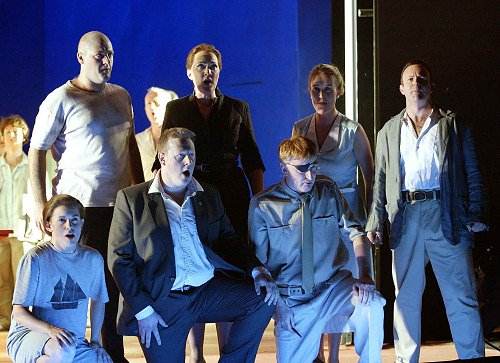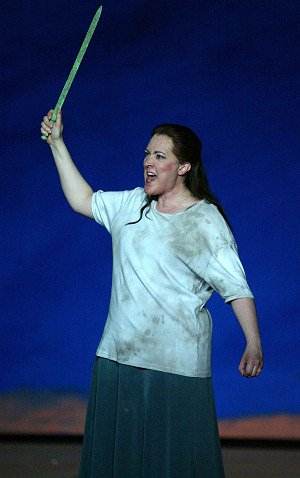S & H Opera Review
Berlioz, The Trojans, Part II: The Trojans at Carthage, English National Opera, Coliseum, London, 8th May 2003 (MA)
The English National Opera presented Part I of Berlioz’s The Trojans in February February, and I was not impressed. Part II, which opened on 8th May, does a marginally better job – but not much. The production, still by Richard Jones, isn’t crippled by Stewart Laing’s feckless designs and costumes; instead, the designer’s duty passes to John MacFarlane, who reveals himself to have a slightly less wayward imagination – though still not a very active one.
The trouble is, as before, that the production does nothing to look inside the music, to promote it, to pick on aspects of the score and illuminate them – any amount of radicality can be tolerated if it does that; indeed, it’s downright exhilarating when it happens. But there’s not much exhilaration to be had in here. Most of the stage business seems irrelevant. For the ‘Royal Hunt and Storm’, for example, the principals spread across the stage and leap up and down, which just looks daft. The approach of the storm is indicated by three screens dropped in front of the stage, each bearing a large painting of a whirlwind and accompanied by some peremptory flashes of the lights – is that the best they can do in these high-tech days? Philippe Giraudeau’s choreography seems to involve pointless gesture more than anything else.
What this production seems to have forgotten is Berlioz’s essential Classicality. For all that he is often described as the Romantic composer par excellence, he was a direct descendant of Gluck and Spontini (two composers he admired deeply): his flashes of Romantic ardour are the more effective because they occur in a framework of Classical restraint. The foreground Romanticism, to put it in Kellerian terms, requires that the background be understood almost as a form of ritual. When the Trojans, their differences of rank undistinguishable, arrive in sneakers and T-shirts to be greeted by Dido in the black tunic of a hospital matron, the loss of formality detracts directly from the impact of the opera as a whole – the surging emotions Berlioz releases gain much of their strength from the disciplined world from which they emerge. Modern dress and bold, colourful sets vitiate that productive duality.
Sandwiched between Sir Colin Davis’ recording for LSO Live and his forthcoming Proms performance, Paul Daniel is bound to find himself in direct comparison with by the pre-eminent Berliozian of the day, and he’s naturally going to be found wanting. Davis can spring the rhythms in a way that keeps the entire thing pointing forward, that gives the score a tensile strength. Daniel is clear, workmanlike, unfussy – he doesn’t make the music his own, as Davis does, but he doesn’t get in its way, either, and the orchestral textures were clear and crisp; Daniel seemed to have paid especial attention to the woodwind, whose sparkling timbres danced through all three hours.
The singing honours were mixed. Susan Parry was a stern Dido, in voice as well as manner – the production gave her little chance to develop much personality in the role. And John Dazsak’s Aeneas was adequate rather than distinguished: his voice takes on a little hardness when it’s under pressure. Their love duet, though, one of the great moments in all music, went straight to the heart; all criticism fell away at that moment. Anne Marie Gibbons, deputising on the opening night for the indisposed Anna Burford, brought warmth and feeling to the role of Anna, Dido’s sister, and Victoria Simmonds was a bold and forthright Ascanius, credibly masculine in her travesty role. The embattled ENO chorus again demonstrated that it is the company’s chief glory.A mixed bag, then, which is already an improvement on Part I. It’s marvellous to hear Berlioz’s glorious music live, of course, but one shouldn’t find in an opera house that one has to close one’s eyes to protect the music from the visual shenanigans on stage.
Martin Anderson
Further performances on 14, 16, 23, 29 and 31 May, and 5 and 7 June. Details at www.eno.org.
Credits: ENO New Production - The Trojans Part II: The Trojans at Carthage
Press Night Thursday 8 May 2003
Photographer: Clive Barda
principals:
Back row, from left to right John Daszak as Aeneas, Susan Parry as Dido,
Anne Marie Gibbons as Anna, Colin Lee as Iopas.
Front row, from left to right Victoria Simmonds as Ascanius, Iain Paterson
as Pantheus, Clive Bayley as Narbal.
Susan Parry as Dido


 Return to:
Return to: